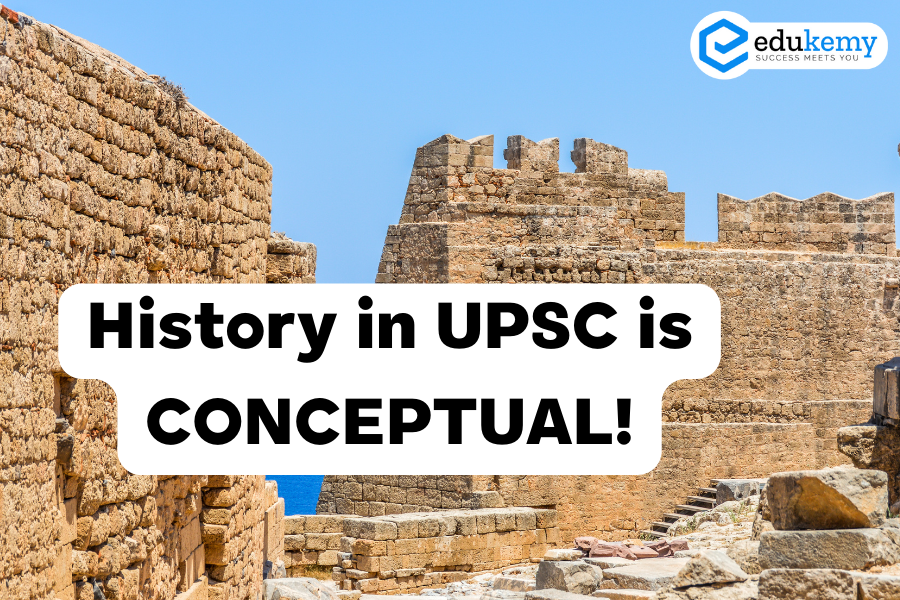It is a common misconception that History in UPSC is all about mugging up.
You must memorize dates, facts, kings, capitals, edits, and places – a lot of places which doesn’t uplift your intellect – rather only push rote learning.
But what if I tell you, that History is about conceptual understanding?
Make no mistake – you will attempt the country’s toughest exam. When looking for Civil Servants, the country is focusing on solid thinkers, rather than ones who can work around things mechanically!
Is there any example that we can quote to make you understand this?
In UPSC Mains 2013, the following question was asked from History Section:
The third battle of Panipat was fought in 1761. Why were so many empire-shaking battles fought at Panipat? (10 marks, 150 words)
When we read History, we tend to read:
1. When were Battle of Panipats fought?
2. Who fought these Battles?
3. Who won/lost the battle leading to what?
But do we ever wonder – WHY were these Battles being fought in Panipat?
The WHY is where the country is seeking thought leaders. This PYQ validates why History for UPSC is to read with concepts, rather than mere dates.
Let’s look at another example, where we seek the difference between the Rig Vedic and the Later Vedic Period.
In the Early/Rig Vedic times, the population was majorly dependent on pastoral, & they led a nomadic life.
Why then, do we see settled agriculture in Later Vedic Age?
- The use of iron started, which meant people could now make plough – meaning agriculture expanded, and with the use of iron, they could increase geographical expansion by cutting through the forests in the Gangetic Plains.
- Furthermore, technological advancements, such as the use of iron tools and irrigation systems, improved agricultural productivity, making cultivation more sustainable and productive.
- Additionally, changes in environmental conditions and the need for surplus production to support non-agricultural activities, such as trade and crafts, further incentivized communities to transition from pastoralism to agriculture.
Similarly, why was there a rise in the state? Why was more allegiance to land rather than cow? Why was there an emergence of a powerful king?
While reading for UPSC – you must focus on WHY of everything. The same goes for History – where you are not just reading WHAT – but rather WHYs.
That’s why, if you read History for UPSC, it becomes so interesting 🙂
Here is a list of differences with the reasons
| Aspect | Rig Vedic Period | Later Vedic Period | Reasons Behind the Change |
| Transition from Pastoralism to Agriculture | During the Rig Vedic Period, society relied heavily on cattle rearing and a semi-nomadic lifestyle due to the abundance of grazing lands. Mobility was essential for accessing these resources. | The Later Vedic Period witnessed a transition to settled agriculture and urbanization. | The transition from pastoralism to agriculture and urbanization occurred due to several interconnected factors. 1. Population growth placed pressure on existing resources, necessitating more efficient food production methods to sustain larger populations. 2. Furthermore, technological advancements, such as the use of iron tools and irrigation systems, improved agricultural productivity, making cultivation more sustainable and productive. 3. Additionally, changes in environmental conditions and the need for surplus production to support non-agricultural activities, such as trade and crafts, further incentivized communities to transition from pastoralism to agriculture. |
| Emergence of Urban Centers | Urbanization was limited during the Rig Vedic Period, with society primarily organized into tribal units. | Urban centers began to emerge during the Later Vedic Period. | The emergence of urban centers during the Later Vedic Period was driven by several converging factors. 1. Economic growth, fueled by surplus agricultural production and increased trade, led to the development of urban centers as hubs for commerce and administration. 2. Additionally, political centralization, driven by the rise of powerful kingdoms (Mahajanapadas), necessitated the establishment of administrative centers in urban areas. 3. Furthermore, cultural exchange facilitated by urbanization fostered interactions between diverse communities, contributing to intellectual and artistic developments. |
| Shift in Religious and Philosophical Focus | Religious practices during the Rig Vedic Period focused on nature worship and rituals performed by priests. | In the Later Vedic Period, there was a shift towards more introspective and philosophical pursuits. | The shift in religious and philosophical focus during the Later Vedic Period was influenced by multiple factors. 1. Cultural evolution, prompted by societal complexity, led to an interest in deeper philosophical inquiries about the nature of existence and reality. 2. Contact with other cultures introduced new ideas and philosophies, prompting a reevaluation of traditional religious beliefs and practices. 3. Additionally, intellectual development encouraged questioning of established norms, leading to a shift in focus towards philosophical inquiry and introspection. |
| Development of Philosophical Texts | The Rig Vedic Period was characterized by an emphasis on hymns and rituals, as seen in the Rigveda. | The Later Vedic Period saw the composition of philosophical texts such as the Upanishads. | The development of philosophical texts during the Later Vedic Period was spurred by several interconnected factors. 1. Increasing intellectual curiosity and sophistication prompted scholars to explore deeper philosophical questions about the nature of existence, reality, and the self. 2. Additionally, cultural exchange facilitated the development of new intellectual currents, as contact with other civilizations introduced new ideas and philosophies. 3. Furthermore, social changes, including urbanization and the rise of powerful kingdoms, created new contexts for philosophical inquiry and introspection. |
We have our UPSC GS Integrated Course starting from 28th March with History – covering History with concepts for both Prelims and Mains. You may check it out and enroll for the same.

Join our Telegram Group for Daily UPSC Quizzes!

